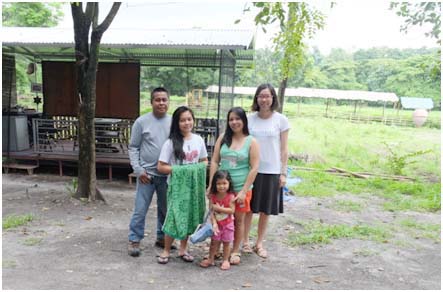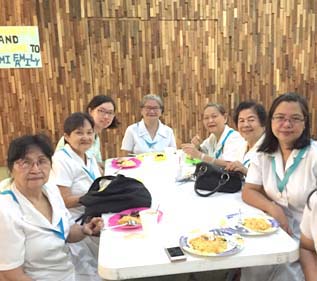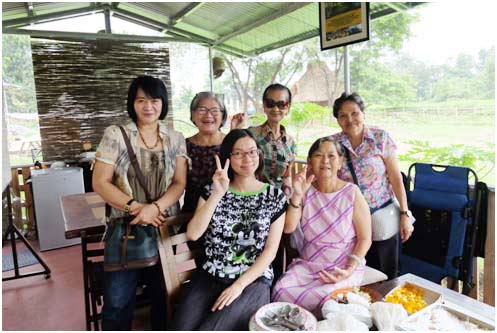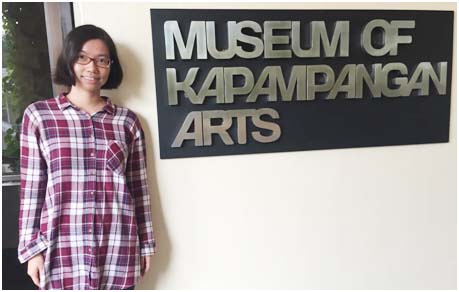This is my last year pursuing Southeast Asian Cultural Studies, focusing on Philippine Studies, also my seventh year learning and using Tagalog.
It occurred to me while considering my upcoming graduation thesis last summer that I needed to visit the Philippines by myself and seek something more concrete and vivid, not just something in books and papers. I contacted Kaisa Para Sa Kaunlaran and they helped me look for a place outside of Manila.
One sunny morning in July, I arrived in Angeles, Pampanga. I was introduced to the happy and hospitable family of Sir Angelo. Upon arrival, my two-month field research immediately began with my accompanying the ladies, Sir Angelo’s mother in-law and her friends, to their weekly senior citizens’ free movie. It was a quick start to this unforgettable journey.
Returning to Beijing on a foggy day, dragging my big trolley case and opening the door of my dorm room, I suddenly recalled the very first day sitting inside Lola Loreng’s car, I was a little nervous and confused at the Kapampangan dialect.
Then all the memories, the faces, the stories, even the automobile exhaust of jeepneys and the deafening sound of tropical rain, flooded back.

My research interest has always been folk Catholicism in the Philippines. So I went many times to the Holy Rosary Church and Apung Mamacalulu Shrine, which are the most frequently visited local churches in Angeles.
I joined in their mass, queued with Atse Meding to touch the lying Apo, visited the palengke and mall listening to people’s explanations and understanding of their beliefs and practices, reading stories and history of the two local Apo sculptures.
I also got to know about other religions, which enriched my view of the Filipinos’ religious life. Then it occurred to me how religions play a fundamental role in organizing those small or big events in people’s lives, offering opportunities for social activities of young and old, responding to different wishes, sanctifying one’s birth, marriage and death, creating occasions for happy feasts and family reunions.
It will be appropriate to apply sociology of religion for me, an atheist foreign researcher, to develop analyses in my thesis using those materials I collected first hand.
Looking back at the time spent in Angeles, I sum it up as an amazing adventure – both about knowing the world and knowing myself.
Before setting out to the field, I had formed some preconceptions. Every time I ask people questions, I first imagined what their answers might be. But my research actually turned out to be a process of eradicating prejudice and preconception as well as exploring the unknown.

For example, based on what I had read, I was prepared to observe the religious rituals which could represent the combination of Catholic and local elements. However, I found that it is not through the rites that one perceives the characteristics of Philippine Catholicism; rather, it is through the way people organize and participate in daily religious life.
I used to regard traditions like magdarame as ancient practice, found only in books, but then I unexpectedly found out the museum staff annually practice it. Here, it is an ordinary custom, which was influenced by Augustinians long ago.
I have always heard people talking about panata and debosyon, but it was not until the last few days of my stay that I realized the importance of these words in explaining people’s behavior.
I was feeling confident and relaxed before packing and leaving, when I abruptly discovered that I was confused about these words and could not clarify the concepts clearly. Thus, I seized every last chance to ask people about these concepts.
What a challenging adventure it turned out to be! Besides gaining objective understanding of the local society, I now also realize the danger of just reading inside a room, allowing one’s self to be bound by subjective and sometimes erroneous conceptions about the world.

But compared with knowing about the world, knowing about yourself is an even tougher puzzle. Fortunately, during my field research, I was able to face myself and reflect about past and present.
When I asked people questions, they also asked me questions back. Why do you learn Tagalog? What are you going to do here? Who pays for your trip? What is your religion? How long have you been here?
They are curious about me, a Chinese who speaks Tagalog. I quickly identified myself not as an external researcher but as an ordinary new acquaintance to the local people.
I honestly thought over those questions, especially the first two, which have been raised countless times.
Six years ago, during college entrance exams, Tagalog was the only major available for my score to be admitted by Peking University. Six years later, I am still in Philippine Studies and have visited this country twice. Am I doing all this only to finish my thesis and accomplish degrees? Perhaps, but that is only part of the answer.

I not only gained language skill and a degree, I also experienced firsthand the culture, what it means and represents, instead of merely knowing the country on a map or news title.
One day while riding a jeepney, a friend of Atse Meding asked: “You came here from Beijing by yourself? Malakas ang loob.”
I regarded her judgment seriously and felt a little moved. The more I learned, the more I try, the further I go. Everything is contributing towards a better me. Three years ago, I was just a cowardly girl who dared not take the jeepney in Manila by herself.
I particularly owe great gratitude to my host family, the Ortegas, in opening up their farm home to me. They generously offered food and accommodation and helped me deal with every trivial problem. I will never forget beautiful and intelligent Abby in her school uniform, the vivacious boys playing and laughing in the heavy rain, and little Shyra calling me Ate Yang.
The kindness and happiness of warm-hearted people I met in the Philippines will be life-long treasures for me. — First published in Tulay Fortnightly, Chinese-Filipino Digest 29, no. 13 (December 06-19, 2016): 16, 12.